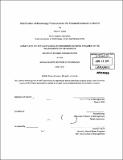Distribution of knowledge production in the chemical sciences in the US
Author(s)
Lohse, Peter A. (Peter Andreas)
DownloadFull printable version (8.075Mb)
Other Contributors
Sloan School of Management.
Advisor
Fiona Murray.
Terms of use
Metadata
Show full item recordAbstract
A citation analysis was carried out to gain an understanding of the geographical and institutional distribution of highly cited articles in the chemical sciences in the US over the last thirty years. The contribution of US chemistry departments was determined by quantifying the number of highly cited articles published by individual authors or groups of authors from the same department. Articles stemming from collaborative research across schools were not considered. The results show that a dilution in intradepartmental knowledge production has occurred both on a geographical and institutional level. Three chemistry departments have emerged as strong producers of high impact articles over the last thirty years: the University of North Carolina, Texas A&M University and the University of Utah. In terms of aggregate numbers of highly cited articles these three schools are in the top ten of over seventy schools which were evaluated; their chemistry departments are en par in terms of scientific impact with those from Ivy League schools like Stanford University, Harvard University and the California Institute of Technology. While the literature reports increasing concentration for the US research base, the present analysis shows a dilution in chemical knowledge production when collaborative efforts across departments and schools are excluded. This finding suggests that the increase in concentration in the US science base is not a uniform trend when studied on a more granular level.
Description
Thesis (M.B.A.)--Massachusetts Institute of Technology, Sloan School of Management, 2011. Cataloged from PDF version of thesis. Includes bibliographical references (p. 43-44).
Date issued
2011Department
Sloan School of ManagementPublisher
Massachusetts Institute of Technology
Keywords
Sloan School of Management.